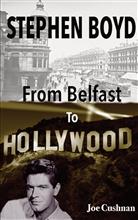Available for freelance writing commissions on a variety of subjects including family history, nostalgic Belfast and its famous people, shops, shoppers & shopping, the golden age of Hollywood (esp westerns) and humorous pieces on life's weird and wonderful. Op-eds, columns, non-fiction book reviews too.
CV of published material available on request.
joecushnan@aol.com & @JoeCushnan
Shooting the Darkness
Iconic images of the Troubles and the stories of the photographers who took them
Trevor Dickson
Paul Faith
Alan Lewis
Stanley Matchett
Martin Nangle
Crispin Rodwell
Hugh Russell
Blackstaff Press 2019
"Based on the acclaimed documentary by Broadstone Films, this landmark book presents the stories of leading photographers – Alan Lewis, Paul Faith, Martin Nangle, Stanley Matchett, Trevor Dickson, Hugh Russell and Crispin Rodwell – whose images captured some of the most important events of the Troubles.They talk, many of them for the first time, about the photographs they took – how they got the shot; what it cost them to take the photograph; and reflect on whether it was worth it.More broadly, they talk about what it was like to be a photographer during the Troubles: how the paramilitary groups dealt with them, the ethical dilemmas they faced, and the emotional fallout they experienced.The book includes the stories behind iconic images such as Bishop Edward Daly waving a blood-stained handkerchief on Bloody Sunday, Sean Downes being shot and killed by an RUC plastic bullet in Andersonstown in 1984, and the brutal attack of corporals Derek Wood and David Howes in March 1988.'
Anyone who uses the term "the Troubles" in reference to some of Northern Ireland's desperate past is in danger of wrapping up history in a couple of words. It is an almost cosy, off-the-cuff term that doesn't even scratch the surface of what actually happened during the forty or so years from the late 1960s.
Many words have been written about those times from all kinds of perspectives, but words are not enough. Photographs have considerable power. They illustrate both humanity and inhumanity. It is easier to skim words but not so easy to ignore an image, especially when it shows tragic fallout and anguish.
This is not a book to flick through in a few minutes. It requires time to reflect on the photographs, what they record, what they represent, and to appreciate the skill and talent involved behind the lens.
Shooting the Darkness is a collection of brilliant photographs by superb photographers. I'll pick out some but, for copyright reasons and sensitivity in some cases, you will have to browse the book shops or buy the book to see the images I describe. This will only scratch the surface.
Trevor Dickson: "Our job was to be right in the thick of it".
A photograph a of woman kissing the hat of her bus-driving husband. He had been shot dead while driving through a gun battle.
Paul Faith: "We take pictures; we don't take sides".
The bloody floor of the Loughinisland bar where six people were murdered and five wounded.
Alan Lewis: "We showed what was happening as honestly as we could".
An ambulance man carrying a dead baby in a blanket.
Stanley Matchett: "The camera was always on my desk with a fresh roll of film in it".
A series of photos showing Father Edward Daly and victims of Bloody Sunday.
Martin Nangle: "That's the nature of working in a job that you're passionate about - you're prepared to take a risk".
A photo recalling the day two off-duty soldiers drove into an IRA funeral cortege and were murdered.
Crispin Rodwell: "There's intuition and instinct, but on top of that there's luck".
A photo of a young boy playing handball against a wall on which someone had painted,
Time for Peace.
Hugh Russell: The older I'm getting, the more I'm starting to realise that we were doing something special".
A photo of a distraught young girl being escorted to school through a hostile crowd.
If my arm was twisted and I was forced to pick just one photograph that upset me the most, it would be Allan Lewis's shot of a 7-year-old boy sobbing uncontrollably at his murdered father's funeral.
Never mind today's stubborn, bickering politicians and history re-writers and those who want to draw a line under the past, a book like this is a necessary and impactful pictorial album that pulls no punches when it comes to showing death, destruction, injury and mayhem, and everlasting grief. And also moments of sympathy, caring and kindness.
As I said earlier, this is humanity and inhumanity captured by an extraordinary number of gifted photographers.











